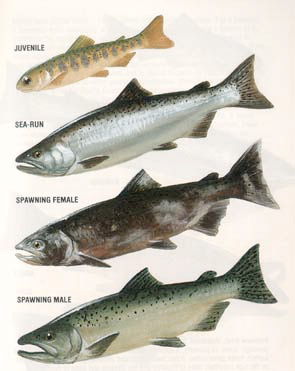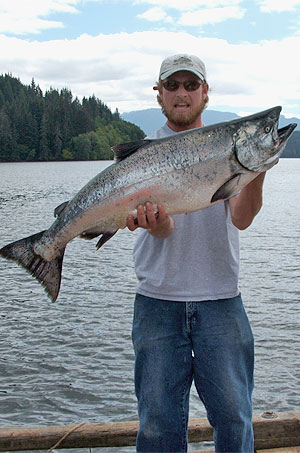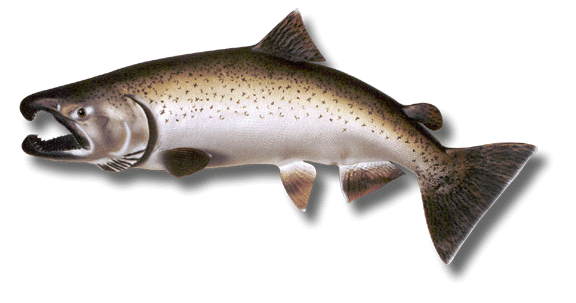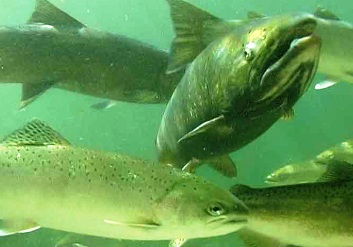|
KING SALMONTop Sport Fish of Alaska
World Record King Salmon -- 97 lbs. 4 oz.
Scientific information (gotta know this!) Kingdom: Animalia Phylum: Chordata Class: Actinopterygii Order: Salmoniformes Family: Sslmonidae Genus: Oncoryhnchus scientific name: Oncorhynchus tshawytscha The “King” is King in Alaska. It is the number one sport fish in the state and is so popular that an entire town has been named after it. The state record, which was taken on the Kenai River is 97.25 lbs., although the typical weight is in the 50 pound range.
These large, lumbering aquatic fish also have several aliases including Chinook, Tyee Salmon, Columbia River Salmon, black salmon, chub salmon and blackmouth. Fly fisherman will attempt to catch Chinook on specialty and locally made
FLY PATTERNS.
When hooked, our advice is to hold on tight because this is the thrill of a lifetime. Check out our
FLY ROD CHART
to be sure you have the correct tool to fight these behemoths.
The frigid waters of the Russian Chukchi sea to the northern Bering Straits near Alaska and all the way down to San Francisco Bay in California is home to these luscious swimmers. Although this species is prevalent in the Pacific ocean, they were transplanted into the Great Lakes in 1967. As a result, the commercial salmon industry in the Great Lakes region has flourished. The King is an anadromous fish and will migrate between fresh water and the ocean. They will begin partying and spawning in September and continue through December. We've all seen the National Geographic films of the bright red salmon in shallow streams. That's the King salmon! After the female lays the eggs, she will guard them for up to 25 days, when she dies (awww!). The eggs will hatch 3 to 5 months later. The young Kings will spend their first year or so in the stream where they were born, then it's off to find their fortune (or misfortune at the end of a hook!) in the sea. The King salmon ALWAYS returns to estuaries or streams to spawn.
What they eat and when As young fry or parr, they will eat plankton, kelp and seaweed as well as jellyfish and starfish. When they mature, they become the hunter and eat other fish smaller than themselves (the bullies). Hence they are a predator and a carnivore. Like most of the salmoniformes, the King salmon eats opportunistically. After all, the King can eat whenever he wants, can't he? It’s good to be “King.”
How we eat them and how to cook 'em King salmon can be prepared in many, many ways. Whether broiled, grilled, smoked or fried, these fish are a satisfying taste treat any time. Here is one off the wall way to enjoy yours.
1 regular pie crust, 9" round 6 oz. cream cheese About 8 ounces of cooked King Salmon 4 medium or large eggs 12 ounces milk 3 medium mushrooms (better slice 'em) 2 finely chopped scallions Pepper In a bowl, mix the eggs, milk and scallions. Add pepper to taste. Reserve for later. Soften the cream cheese and spread evenly in bottom of pie crust. Use a fork to flake the King salmon over the cream cheese. Add the reserved egg mix. Layer the mushrooms on the top. Put into a 350 degree oven for about 45 min. Cool for at least 20 minutes, then serve. Other species like this one and their differences
The King resembles other salmon, yet has less of a hook on the nose than other similar species. For this reason, they may be thought to be an ocean trout of some kind. The difference is the coloration. Where trout species have mottled skins all over, the King is a lovely blue-green on the back with silver/white sides. It does have spots like a spotted trout, but only on the upper half of the body. The mouth is a dark grey, earning it the pseudonym "blackmouth" salmon.
Catch one for me. Better yet,
CATCH and RELEASE
one for me. I love these fish!!
Freturn from King Salmon to Fish Species
|









